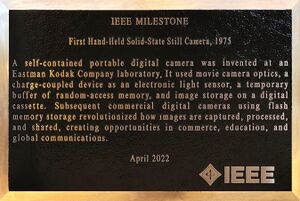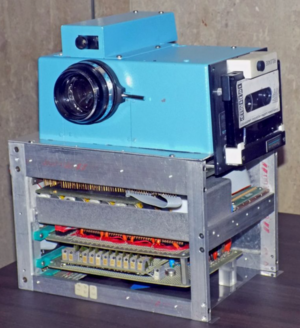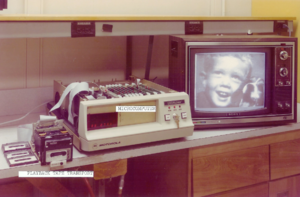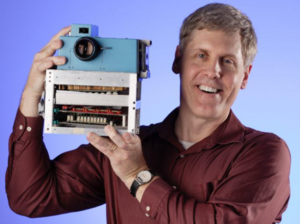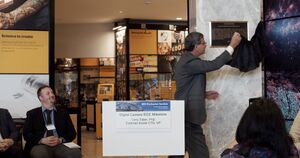Milestones:Handheld Digital Camera, 1975
Title
First Hand-Held Solid-State Still Camera, 1975
Citation
A self-contained portable digital camera was invented at an Eastman Kodak Company laboratory. It used movie camera optics, a charge-coupled device as an electronic light sensor, a temporary buffer of random-access memory, and image storage on a digital cassette. Subsequent commercial digital cameras using flash memory storage revolutionized how images are captured, processed, and shared, creating opportunities in commerce, education, and global communications.
Channel 13 WHAM news coverage of the dedication.
You can listen to the radio news story about the dedication ceremony courtesy of WXXI Radio.
Street address(es) and GPS coordinates of the Milestone Plaque Sites
Kodak Center, 200 W Ridge Rd, Rochester, NY 14615 US, (GPS: 43.198318, -77.630898)
Details of the physical location of the plaque
On a marble pillar in The Gallery at Kodak Center, located off the ground floor lobby, adjoining an exhibit area whose artifacts include the world's first digital camera as created at Kodak by Steven Sasson.
How the plaque site is protected/secured
The Gallery is protected by a guard station. Access is free to the public, 9am-5pm on weekdays and during select events.
Historical significance of the work
Digital camera are device for making digital recordings of images. Back in 1975 when Steve Sasson invented the digital camera there was no internet, and all pictures were taken using film camera and film had to be developed and in some cases printed to be able to see the pictures. Generally, you took the pictures today and didn't see the results for several days.
Today you can buy just about any kind of digital camera you like. Cameras are available in cell phones, handhelds, toys, pens, tablets, glasses, and lots of other gadgets. Almost anyone can afford a digital camera and millions own at least one model and can take pictures for instant review, sharing on social media, archiving, and printing. The uses are so much more varied than images were before the digital camera that it is virtually incalculable.
Features that set this work apart from similar achievements
Probably the earliest proposal for the use of digital image capture was written by Eugene F. Lally of the Jet Propulsion Laboratory who proposed in 1961 using a photosensor to capture telescopic digital images of the planets and stars. He declined funding in 1973 to actually build such a system citing other priorities. https://en.wikipedia.org/wiki/Eugene_F._Lally
The Cromemco Cyclops was an all-digital camera introduced as a commercial product in 1975. Its design was published as a hobbyist construction project in the February 1975 issue of Popular Electronics magazine, and it used a 32×32 Metal Oxide Semiconductor sensor. The Cyclops was primarily a tethered motion video device, the title for our milestone clarifies that we are claiming a portable still image camera. " First Hand-Held Portable All-Electronic Solid-State Still Camera, 1975" https://en.wikipedia.org/wiki/Cromemco_Cyclops
Steven Sasson, an engineer at Eastman Kodak, invented and built a self-contained electronic camera that used the Fairchild MV-101 a 100 x 100 pixel charge-coupled device (CCD) image sensor in 1975. Specifically, the device was the first hand-held camera to include camera optics, a charge-coupled device electronic light sensor, a temporary buffer of random-access memory, and image storage on a digital cassette. Sasson and co-inventor Gareth Lloyd were granted the first patent "US4131919 Electronic still camera" with a filing date of 20-May-1977.
Significant references
https://www.invent.org/inductees/steven-sasson
https://www.cnet.com/news/photos-the-history-of-the-digital-camera
https://www.diyphotography.net/worlds-first-digital-camera-introduced-man-invented
https://www.thevintagenews.com/2016/07/25/steve-sasson-invented-the-first-digital-camera-in-1975-but-was-forced-to-keep-it-hidden
https://youtu.be/2yDLEBsThvk
https://fstoppers.com/education/story-worlds-first-digital-camera-told-its-inventor-215236
https://lens.blogs.nytimes.com/2015/08/12/kodaks-first-digital-moment/
US Patent 4,131,919 - "Electronic Still Camera" Inventors: Gareth A. Lloyd and Steven J. Sasson; filed on 20 May 1977
The Journal of Strategic Information Systems, Volume 18, Issue 1, March 2009, Pages 46-55
The Journal of Strategic Information Systems, Disruptive technology: How Kodak missed the digital photography revolution, Henry C.Lucas Jr. and Jie MeinGoh, https://doi.org/10.1016/j.jsis.2009.01.002
Yoo, Youngjin, Kalle Lyytinen, Veeresh Thummadi, and Aaron Weiss, "Unbounded innovation with digitalization: A case of digital camera," In Annual Meeting of the Academy of Management, pp. 1-41. 2010.
Text from Unbounded Innovation with Digitalization: A Case of Digital Camera:
Introduction
On November 2009, Willard Boyle and George E. Smith received Nobel Prize in Physics for their invention of charge-coupled device (CCD), a key component of digital cameras. When they invented CCD in 1969 at AT&T Bell Labs, little did they know that their invention would affect the lives of billions of people around the world three decades later. Conceived merely as a technical exercise, the original digital camera was first built by Steven Sasson at Eastman Kodak in December 1975. It weighed 8 pounds with its toaster-size body, and took 23 seconds to capture an image of 0.01 megapixels on a cassette tape. It required a separate TV to see the image, which took another 23 seconds to retrieve. 30 years later, however, digital camera has become ubiquitous.
Supporting materials
IEEE Spectrum stories:
- The First Digital Camera Was the Size of a Toaster
- Spotlight on Steven J. Sasson: An interview with the inventor of the first digital camera
